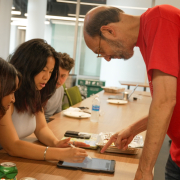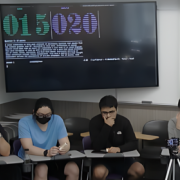UMD Concludes 12th Annual REU Summer Program
The University of Maryland's Department of Computer Science has successfully concluded its 12th annual Research Experiences for Undergraduates (REU) program, sponsored by the National Science Foundation (NSF). From June 3 through August 9, the program brought together 18 undergraduate and three high school students from across the United States, providing them with hands-on research experience in cutting-edge projects that focus on machine learning, artificial intelligence, quantum computing and algorithms.
Participants worked on various projects under the mentorship of UMD faculty and graduate students, receiving valuable guidance and insights. Participants were awarded a $7,000 stipend and room and board at UMD.
The program, established at UMD in 2013, has steadily grown in popularity, attracting a diverse group of students eager to explore the complexities of computer science research. William Gasarch, a professor of computer science who spearheaded UMD's involvement with the REU program, continues to champion the students’ achievements.
 "The students were great," Gasarch said. "There were two projects in AI, two in algorithms, and three in quantum computing. They all required intense work—reading papers, thinking and writing code. Ultimately, they will all contribute to their fields in numerous ways."
"The students were great," Gasarch said. "There were two projects in AI, two in algorithms, and three in quantum computing. They all required intense work—reading papers, thinking and writing code. Ultimately, they will all contribute to their fields in numerous ways."
The program aims to equip students with essential research skills, focusing on developing abilities such as reading and writing academic papers, delivering presentations and conducting meaningful research.
One of this summer’s research projects explored quantum graph games, focusing on graph homomorphisms and their connections to various quantum and classical properties. Ph.D. students Seyed Sajjad Nezhadi and Jon Nelson led the project.
Nezhadi highlighted the project's significance to the field of computer science.
“Planarity in graphs is crucial because it determines whether a network can be drawn on a 2D grid without needing bridges or tunnels,” Nezhadi said. “For example, in chip design, planarity helps determine if all necessary connections can be made on a single chip layer or if additional wiring is needed. In the context of our research, planarity is a natural graph property we explored, similar to how three-coloring is used in graph theory.”
The hands-on nature of the REU program provides students with an invaluable experience, blending academic research with practical application.
Jakin Ng, a rising senior at MIT double-majoring in math and computer science, participated in Nezhadi’s project and shared her experience within the program.
“I had a fun and impactful time,” Ng said. “The program’s coordinators did a great job with social activities, and I enjoyed getting to know other students interested in CS research. My project on quantum graph games was guided by incredible mentors who provided valuable direction and advice. I particularly enjoyed working with my project partner, Bea Fatima, and we collaborated effectively. Overall, REU was a great experience, and I learned a lot about quantum and computer science research.”
Another project led by Jordan Boyd-Graber, a professor of computer science, and Tasnim Kabir, a fifth-year computer science doctoral student, aimed to deepen the understanding of AI models' limitations and enhance system comprehension across different modalities, including images, video, and sound.
 UMD information science graduate student Yoo Yeon Sung, who played a key role in the project, shared her insights on its eventual impact in the field.
UMD information science graduate student Yoo Yeon Sung, who played a key role in the project, shared her insights on its eventual impact in the field.
"We developed ADVSCORE, a metric that assesses the effectiveness of adversarial datasets by measuring their adversarial and discriminative qualities," Sung said. "This led to the creation of the ADVQA dataset, which enhances understanding and mitigation of model vulnerabilities. Ultimately, this work will enhance the understanding and mitigation of model vulnerabilities, contributing to developing more resilient AI systems."
As the program concluded, the participants presented their research findings in a series of presentations attended by faculty, mentors and fellow students. These presentations showcased the students' hard work over the summer and allowed them to practice their public speaking and presentation skills, which are crucial in academic and professional settings.
Gasarch emphasized the program's role in shaping students' academic and professional futures and offered advice on making the most of the experience.
“REU programs, mine and others, are 10 weeks of the summer,” Gasarch shared. “After those 10 weeks, you have a much better idea about if you want to go to grad school and do research. Secondly, the REU programs are very competitive, so I would recommend applying to at least ten of them; however, only apply to those with projects you would want to work on.”
Other REU projects included:
• Laxman Dhulipala, an assistant professor of computer science with an appointment with the University of Maryland Institute for Advanced Computer Studies (UMIACS), and Tobias Rubel, a fourth-year computer science doctoral student, explored parallel algorithms. Students worked on designing data structures and algorithms for Approximate Nearest Neighbor (ANN) search in high-dimensional spaces, focusing on writing scalable code in C/C++ for multicore CPUs. The project involved algorithm design, parallel programming and benchmarking on large datasets.
• David Mount, a professor of computer science with an appointment in UMIACS, and Auguste Gezalyan, a fourth-year computer science doctoral student, explored the Hilbert Metric within the field of computational geometry. Students investigated how this metric, which has applications in genetics, probability and physics, behaves in various contexts, including the probability simplex. The project involved theoretical exploration and practical application, contributing to a software package for visualizing these geometric structures.
• Aviva Prins, a fifth-year computer science doctoral student, developed a decision support tool for crop planning using multi-agent reinforcement learning. The project focused on optimizing crop planning advice for small and marginal farmers in India, aiming to improve their income while avoiding supply-demand imbalances in the market. The project was in collaboration with Kheyti, a nonprofit organization in India.
• Victor Albert, a fellow in the Joint Center for Quantum Information and Computer Science (QuICS), and Nat Tantivasadakarn, a postdoctoral research associate in theoretical physics at the California Institute of Technology, focused on classical and quantum error correction. Students contributed to the Error Correction Zoo, a repository for error-correction schemes, with opportunities ranging from basic data entry to exploring advanced topics like topological codes and approximate quantum error correction.
• Andrew Childs, a professor of computer science and QuICS fellow, and James Watson, a postdoctoral researcher at QuICS, focused on computing error bounds for quantum simulation algorithms. The project developed theoretical and computational methods to calculate error bounds for product formulas used in quantum dynamics simulations. These methods were implemented in software to help determine resource requirements for practical quantum simulations.
—Story by Samuel Malede Zewdu, CS Communications
The Department welcomes comments, suggestions and corrections. Send email to editor [-at-] cs [dot] umd [dot] edu.
